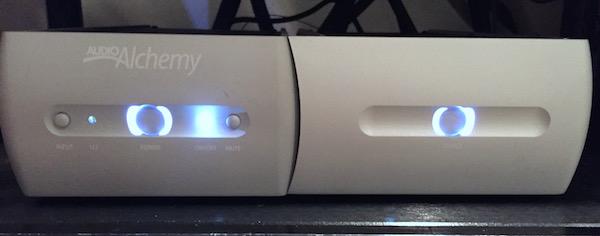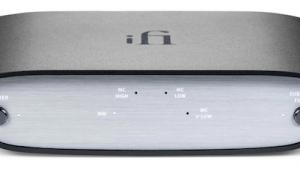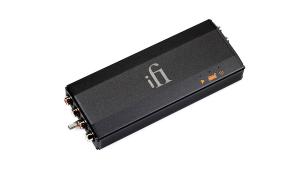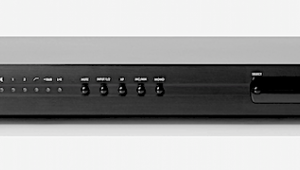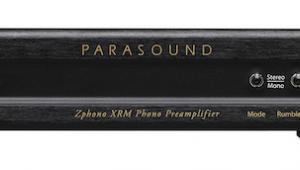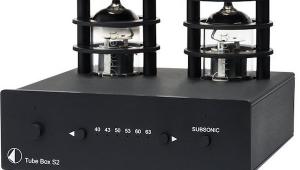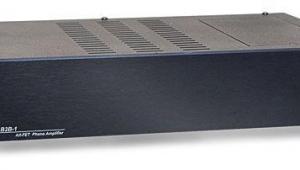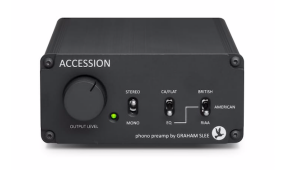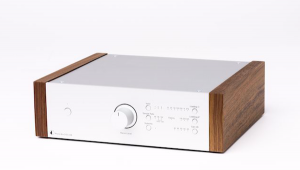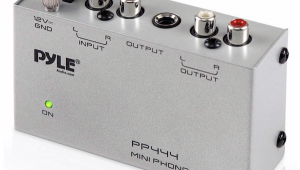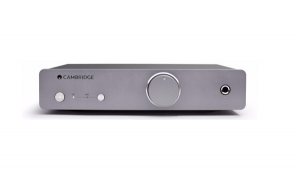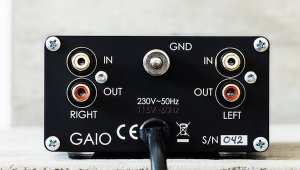Audio Alchemy's High Performance PPA-1 MM/MC Phono Preamplifier
What some people forget is that aside from producing reasonably priced, high performance gear, the company also issued some truly high tech products like the Digital Transmission Interface Pro32, which included an I2S interface that produced a low jitter connection between a transport the company also made that had an I2S output and DAC.
The transport was based on Pioneer’s “upside down” mechanism that I continue to use to this day. It also produced a headphone amp back before headphones became as popular as they are today.
Peter Madnick, who led the engineering team that created all of these innovative designs, resurrected the Audio Alchemy brand a few years ago, building the new products in a California factory that, conveniently, he owns.
If you're unfamiliar with Madnick's back ground and achievements you should read this.You'll also read there the team Madnick has assembled to design and produce all of the new Audio Alchemy.products.
The PPA-1 is Madnick’s move into the phono preamplifier market and given his history you’d be correct in assuming it’s both reasonably priced and innovative. The case work is also worlds beyond that of the old Audio Alchemy.
The PPA-1, which costs $1795, is a MM/MC phono preamplifier that uses all-discrete FET gain and equalization stages. It features two inputs that can be set for either MM or MC, and both single-ended and balanced XLR outputs.
Moving coil loading is unique in that it’s continuously variable from 1ohm to 1000 ohms and individually adjustable for each channel and for either input via four back panel potentiometers.
Of course you can do this “by ear”, but better is to use an inexpensive multimeter to measure the exact resistive setting via test points located on the back panel adjacent to the dipswitches used to set MM or MC for each input as well as either fixed 47Kohm loading or variable via the potentiometers.
All of this is enclosed in an unusually handsome and well constructed case that gives you the feeling of having gotten something substantial for your $1795.
. The standard power supply is a small outboard transformer that outputs 9 volts AC. An optional $595 PS-5 power supply the size of the PPA-1 itself provides superior filtration, tighter voltage regulation, lower noise and greater energy storage.
The PPA-1’s specifications are impressive:
Frequency Response
±0.1 dB, 10 Hz to 20 kHz
Nominal THD+N
<0.005% at 1 kHz
Signal-to-noise ratio (1 kHz)
High-gain input shorted: 67 dB unweighted, 76 dB A-weighted
Low-gain input shorted: 84 dB unweighted, 90 dB A-weighted
Gain
High-gain setting: 67 dB
Low-gain setting: 49 dB
Input sensitivity (1 kHz)
High gain: 450V input for 1 VRMS balanced output
Low gain: 3 mV input for 1 VRMS balanced output
Input impedance
fixed 47 kΩ or variable 1Ω to 1000Ω
Output impedance
100Ω unbalanced, 100Ω per leg balanced
Channel separation (1 kHz)
High gain: -88 dB
Low gain: -100 dB
Should You Buy a MM/MC Phono Preamplifier For Use With a MM Cartridge?
This is a question you need to ask yourself. Let’s say you have a turntable fitted with a MM cartridge now but plan at some point in the future to install a low output MC cartridge. Do you buy a MM only phono preamp now?
Or buy a MM/MC preamp so you’re set for the future? Keep in mind in making your decision that you can always keep your MM-only phono preamp and add a “head amp” or a step up transformer later to use with your MC cartridge.
While I began my PPA-1 audition using its MC input (you can “hear” it here), let’s start with the MM input.
I auditioned the MM input using a $295 Rega Elys 2 cartridge that came mounted on a Rega RB330 arm that’s standard on the Planar 3 turntable.
I’ll get to the conclusion quickly: as a $1795 MM phono preamplifier, the PPA-1 was different from but not necessarily bettered by the remarkable Swedish Lejonklou Gaio that costs $895 and is available through Osage Audio.
The PPA-1 had more robust bass, and greater dynamic “punch”, but the Gaio produced a more pleasingly liquid and lush midrange. These were two different presentations, both attractive in their own ways, but I won’t say the PPA-1’s sound was twice as good or even as good depending upon your tastes and or what you most value.
The differences were obvious on a variety of records I auditioned including the Music Matters reissue of Larry Young’s Unity (MMBST-84221), and new sumptuously produced Willie Nelson Ray Price tribute album Willie Nelson/For the Good Times A TRIBUTE TO RAY PRICE (Sony/Legacy 88985314241).
I preferred the PPA-1 on Unity because of the greater transient snap to Elvin Jones’s snare drum and more air around Woody Shaw’s trumpet, but on the Willie Nelson, I preferred the Gaio’s rendering of his voice and the more natural sheen to the lush string section.
Of course it’s possible the PPA-1 was more accurately rendering the recording. I’m just saying if you prefer lush to detailed and you’re running a moving magnet cartridge you might want to save yourself $900.
Of course the Gaio is a featureless box with but one input but if you have but one turntable fitted with a moving magnet cartridge, it’s well worthy of your consideration though the MC upgrade path via a good step-up transformer will add at least another $1000 (the highly recommended Bob’s Devices Sky CineMag costs $1250). That brings the cost of a MC ready phono preamp up to $2150, which is $240 less than the cost of the…
Audio Alchemy PPA-1 with the PS-5 power supply in Moving Coil Mode.
I swapped out a $28,000 phono preamp under review for Stereophile for the PPA-1, running it “balanced out” first without and then with the PS-5 optional power supply, which, by the way has a second port to power, I assume, Audio Alchemy’s Line preamplifier.
Now here’s where the PPA-1 becomes really great! I plugged in the Doehmann Helix 1 turntable (approximately $45,000 with arm) currently under review for Stereophile. The custom Schroeder arm carried a Lyra Etna cartridge ($8995).
So the PPA-1 is in a system that’s way out of its price league but had I not know how much it cost, especially given the snazzy casework, I’d have figured probably double the price.
Replaying the Willie Nelson Ray Price tribute album produced a large-screen three- dimensional picture with Nelson’s voice hovering in three dimensions between the speaker. The strings, pedal steel guitar and background signers were each in unique spaces on the stage and most importantly, the sound never “stuck” to the speakers.
The PPA-1 produced reasonably robust and well-focused bass and was overall rhythmically taut. The mids were still not the richest and most delicately rendered, nor were backgrounds super black, though the PPA-1 was very quiet.
I played the lush and delicate Desmond Blue—Paul Desmond With Strings (RCA LSC-2438) a spacious recording produced at New York’s Webster Hall and poorly reissued recently by Pure Pleasure.
I can’t recommend that one. It sounds oddly compressed dynamically and spatially. Desmond’s signature breathy sax sound is almost unrecognizable. The picture is flat and congested.
Overall the PPA-1’s rendering of this sonic gem (the original) was a bit dry and less then fully fleshed out, but the tone, texture and transients of Jim Hall’s guitar were convincing as was the instrument’s three dimensional image.
Then I shut down the PPA-1 and inserted the PS-5.
While the unit’s overall tonal balance remained essentially the same everything else improved, particularly the bottom end control, which greatly contributed to greater rhythmic thrust. Backgrounds became blacker and image focus and three-dimensionality improved. One thing that really impressed on the PPA-1/PS-5’s rendering of the Desmond record was the way it reproduced a very distant and softly played drum set on “I’ve Got You Under My Skin”. There are some very distant cymbals and tom hits that were finely woven and believable—not to mention sounding as if they were located in my side yard.
I again played the Monty Alexander album just reviewed, imagining what it would sound like compared how it had sounded through the $28K phono preamp and my reference Ypsilon VPS-100 and the bass, especially was way better than I’d been expecting.
Overall, the PPA-1/PS-5 produced an impressively well-balanced rendering of what had become a very familiar album. I could point out the differences between the PPA-1/PS-5 and the very expensive phono preamp but that would just be a waste of our time.
Conclusion
If you are now running a moving magnet cartridge with no plans in the near future to replace it with a low output moving coil cartridge—especially if you prefer a rich, full sound at the expense of some dynamic expression—you should consider the $895 Lejonklou Gaio.
If you’re running a low output moving coil cartridge (or two or one MC and one MM) and you are looking for solid state in the under $2000 price range the Audio Alchemy PPA-1 is easy to recommend for its high build quality, attractive exterior, fully adjustable MC loading options, two input convenience and of course its accomplished sonics and background quiet.
I wouldn’t recommend adding the power supply until you’ve decided you like the stand-alone PPA-1 because while the PS-5 produces an improvement that’s substantial and easily heard, it doesn’t alter the PPA-1’s overall tonal personality, which, like any other piece of audio gear at any price, is taste-dependent.
To conclude: PPA-1 is a high performance, feature-rich, versatile, well-built in America, MM/MC phono preamp that is among a handful of the best under $2000 phono preamplifiers available today—at least that I’ve heard.
